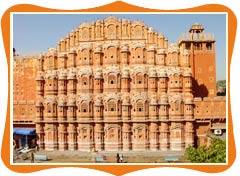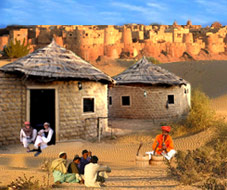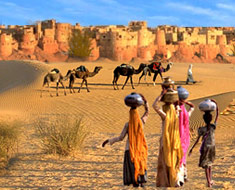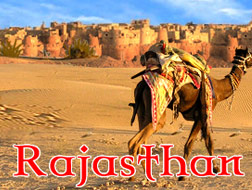 Jaipur city is believed to be one of the first planned cities of India in the medieval era. The characteristic rose colored sandstone architecture, manifested in many beautiful palaces, forts, and havelis, has earned the capital of Rajasthan the name of "Pink City". The heritage city of India is nearly 260 km away from Delhi, the capital of India. Jaipur literally means the 'city of victory' and was constructed by Raja Sawai Jai Singh II in 1727. It was the increasing population of Amber and the water scarcity that prompted Raja Sawai Jai Singh II to plan the new capital of Jaipur in the plains. And it was under the guidance of Shaspati (Hindu priest architect) Vidyadhar Bhattacharya of Bengal that the walled city was built, in a grid system with wide straight avenues, roads, streets, and lanes. Nine rectangle shaped city spheres, laid out in broad, spruced up roads constitute the avant-garde architectural framework of Jaipur.
Jaipur city is believed to be one of the first planned cities of India in the medieval era. The characteristic rose colored sandstone architecture, manifested in many beautiful palaces, forts, and havelis, has earned the capital of Rajasthan the name of "Pink City". The heritage city of India is nearly 260 km away from Delhi, the capital of India. Jaipur literally means the 'city of victory' and was constructed by Raja Sawai Jai Singh II in 1727. It was the increasing population of Amber and the water scarcity that prompted Raja Sawai Jai Singh II to plan the new capital of Jaipur in the plains. And it was under the guidance of Shaspati (Hindu priest architect) Vidyadhar Bhattacharya of Bengal that the walled city was built, in a grid system with wide straight avenues, roads, streets, and lanes. Nine rectangle shaped city spheres, laid out in broad, spruced up roads constitute the avant-garde architectural framework of Jaipur.Today, Jaipur - The Pink City, is one of the most sought-after tourist destinations of India and is visited by millions of visitors from across the globe. It has all the necessary requisites of a modern day city and is a major business centre along with being a modern industrial city. The structures in the city are reminiscence of the bygone Rajput royal era that recount the story of chivalry and romance of the Rajput rulers. The Amber Fort, Jaigarh Fort, Nahargarh Fort, City Palace, and Hawa Mahal are some remarkable pieces of architecture which leave the spectators bewiwtched with their superb architectural craftsmanship. Jaipur city, with its beautiful bazaars offering beautiful fabrics, handicrafts, exquisite furniture, and gemstones, is a major draw for all tourists. Apart from this, woolen carpets, cotton rugs, and leather footwear, especially the embroidered jooties, are some items the city is famous for. One can choose to shop at Rajasthali, Johari Bazaar, MI Road, Nehru Bazaar, and stalls at Bari & Choti Chaupars.
According to the 2008 Conde Nast Traveller Readers Choice Survey, Jaipur was ranked as the 7th best place to visit in Asia and was ranked 3rd among the 12 major cities of India in another poll. With a well maintained road network and well planned colonies, the infrastructure is developing quickly and the city, itself, is expanding drastically. Three major water bodies - the Ban Ganga, Banas, and the salty Sambhar Lake, not only fulfill the water requirement of the city, but infuse it with splendid natural beauty. On three sides, the city is surrounded by rugged hills. Numerous festivals and fairs, like Teej festival, Kite festival, Elephant Fair, Gangaur Fair, Sitla Mata Fair, and Chaksu Fair keep the ethnicity and culture of the region alive. If not for anything, a visit to Jaipur is worth experiencing the hospitality of the people of the Pink city.
Amber Fort
Constructed by Raja Man Singh I in 1592 and completed by Mirza Raja Jai Singh, the Amber Fort is a fantastic blend of Mughal and Rajput architecture at its best. Built in red sandstone and white marble, the fort provides spectators with a magnificent sight. It is as good as a standalone fort as it is a complex of palaces, halls, pavilions, gardens, and temples.
City Palace
Situated in the midst of the heart of the walled city, City Palace Jaipur was built by Raja Sawai Jai Singh and later, the rulers that followed, made extensions to it. A section of the City Palace still serves as the residence of the royal family of Jaipur. The palace is an ideal example of a blend of Mughal and Rajput styles of architecture. It has a string of imposing halls and small palaces within its complex, which are sure to bewitch the spectators through their colorful motifs and intricate carvings on the wall.
Hawa Mahal
The Palace of Winds, located in the heart of the city of Jaipur, is an unusual structure with 953 small windows known as "Jharokas", at the large wall facing the street, today. The numerous latticed windows were constructed to allow the cool breeze to enter in the hot months of summers. The magnificent Hawa Mahal is an architectural wonder, beautified with intricate jali work on the 953 casements which are sure to, undoubtedly, spellbind the spectators.
Jaigarh Fort
Jaigarh fort, also known as the fort of victory, is one of the three hilltop forts that overlook the pink city of Jaipur. Situated approximately 15 km away from Jaipur on the hill premonitory called Cheel ka Teela (Hill of eagles) of the Aravali hill ranges, the fort was constructed between 15th and 18th centuries. Jaigarh Fort is also famous for housing the world's largest canon on wheels, Jai Ban (Jaivan).
Jantar Mantar
Located opposite the gate of the City Palace, the Jantar Mantar of Jaipur is the world's biggest stone astronomical observatory which is still in a functional condition. Constructed wholly with stone and marble, Jantar Mantar houses fourteen architectural astronomical instruments and is one of the famous five astronomical observatories built by Maharaja Sawai Jai Singh II.










